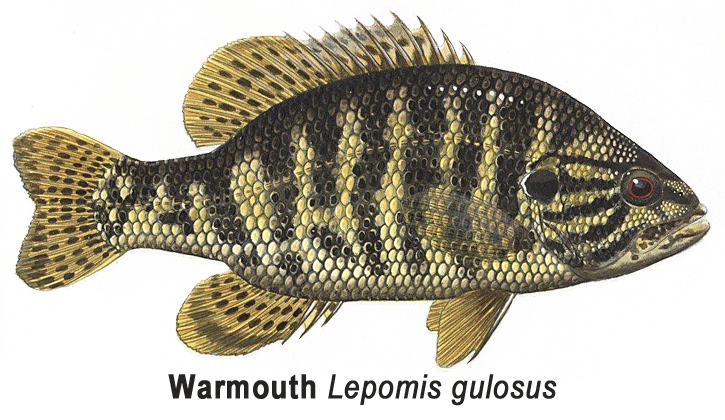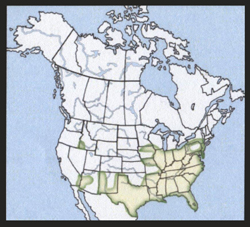Warmouth, October 2014, Fish of the Month!
 Warmouth
Warmouth
Lepomis gulosus
Local Names:
Goggle-eye, Stumpknocker, Mud bass, Jug-mouth, Big-mouth
Average Size:
7 to 9 inches
Distinguishing Field Marks:
(See the illustration.)
-
The body is less deep and less laterally compressed than most of the rest of our small sunfishes, although its shape can be sometimes be confused with that of the Rock bass.
-
The Warmouth has about 10 dark vertical bands on its sides, the Rock bass has about 5.
-
The Warmouth has a series of dark diagonal stripes on its head.
The ear flap is very short with a black center and thin white outline.
The eye has a red border on its pupil.
The mouth is of moderate size with its upper jaw extending back to the mid-point of the eye.
The first and second dorsal fins are joined.
The caudal fin is slightly forked with rounded lobes.
The anal fin has 3 spines on its leading edge, the Rock bass has 6 anal fin spines.
North American Range:
Map to the right shows approximate range in North America.
Diet:
The adult Warmouth's diet includes immature and adult aquatic insects, other aquatic invertebrates such as snails and small crayfish, and some small fishes.
One of the Warmouth's common names, "Stumpknocker" derives from its being observed repeatedly jumping to bounce against the sides of stumps and other low structures jutting above the water's surface in an attempt to dislodge any food that might be resting there.
Biology:
The Warmouth spawns in late spring and early summer at water temperatures of about 69 degrees F.. Although the spawning behavior is nearly identical to that of the other small sunfishes, male Warmouth locate their nests near bottom structure, especially stumps, rocks, or dense rooted vegetation in 18 to 48 inches of water. Because of this preference, Warmouth nests are not often found in dense colonies like those of the Pumpkinseed or Bluegill, unless their preferred sites are scarce. For the purpose of guarding their nests against intruders, male Warmouth display using their eyes which turn bright red, their bodies which become bright yellow, and flare their gill covers. The rest of the spawning behavior is similar to that of the other small sunfishes, with the males fanning the incubating eggs and protecting the newly-hatched young for a short period.
Adult Warmouth prefer warm water, often in the 80 to 85 degree F. range.
Fly Fishing for Warmouth:
Warmouth are found in shallow lakes, ponds, sloughs and slow-moving streams with soft, usually muddy bottoms and an abundance of rooted and floating vegetation. They are most accessible to anglers in spring before the weed beds are fully developed and the water is more open. Later in the season, getting through the weeds to present a fly or popper to these fish can be nearly impossible.
Warmouth will take a variety of small sinking flies, small poppers, and foam bodied bugs or beetle imitations. Whatever are your favorite sunfish flies should also work well for this species. As with all our small sunfishes, light tackle is the most sporting: 3 to 4 weight systems are ideal. If you're serious about fly rodding for Warmouth, you might consider carrying a reel spool loaded with a sink-tip line for fishing your wet flies.
Significance to Humans:
This is yet another of our small sunfishes which is not often targeted by anglers either for sport or food, although, like its near relatives, it is good eating, and can also be an interesting addition to a home aquarium.
Status:
Maintaining, entirely through natural reproduction.






